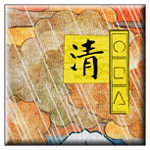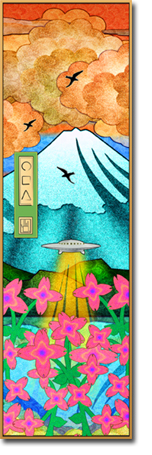On The Way: The Daily Zen Journal
On Gardens and the Way
Muso Soseki (1275-1351)
From ancient times until now there have been many who have delighted in raising up mounds of earth, making arrangements of stones, planting trees, and hollowing out watercourses. We call what they make “mountains and streams.” Though all seem to share a common liking for this art of gardening, they are often guided by very different impulses.

There are those who practice the art of gardening out of vanity and a passion for display, with no interest whatever in their own true natures. They are concerned only with having their gardens attract the admiration of others.
And some, indulging their passion for acquiring things, add these “mountains and streams” to the accumulations of rare and expensive things that they possess, and end up by cherishing a passion for them. They select particularly remarkable stones and uncommon trees to have for their own. Such persons are insensible to the beauty of mountains and streams. They are merely people of the world of dust.
Po Lo-t’ien dug a little pool beside which he planted a few bamboos, which he cared for with love. He wrote a poem about them:
The bamboo—its heart is empty.
It has become my friend.
The water—its heart is pure.
It has become my teacher.
Those everywhere who love mountains and rivers have the same heart as Lo-t’ien and know the way out of the dust of the world. Some whose nature is simple are not attracted by worldly things, and they raise their spirits by reciting poems in the presence of fountains and rocks. The expression “a chronic liking for mist, incurably stricken by fountains and rocks” tells something about them. One might say that these are secular people of refined taste. Though they are in the world and without the spirit of the Way, this love of the art of gardens is nevertheless a root of transformation.

In others there is a spirit that comes awake in the presence of these mountains and rivers and is drawn out of the dullness of daily existence. And so these mountains and rivers help them in the practice of the Way. Theirs is not the usual love of mountains and rivers. These people are worthy of respect. But they cannot yet claim to be followers of the true Way because they still make a distinction between mountains and rivers and the practice of the Way.

Still others see the mountain, the river, the earth, the grass, the tree, the tile, the pebble, as their own essential nature. They love, for the length of the morning, the mountain and river. What appears in them to be no different from a worldly passion is at once the spirit of the Way. Their minds are one with the atmosphere of the fountain, the stone, the grass, and the tree, changing through the four seasons. This is the true manner in which those who are followers of the Way love mountains and rivers.
So, one cannot say categorically that a liking for mountains and rivers is a bad thing or a good thing. There is neither gain nor loss in the mountain and the river. Gain and loss exist only in the human mind.

Bamboo Garden
The third one crooked the second one leaning
bamboos have grown
by the stone steps of the garden
every year
there are more of them
until now they are a forest
At the clack of a stone on a bamboo
Hsiang-yen shattered
the uncountable worlds
but this garden
continues in its green shade
just as before
Muso Soseki (1275-1351)

Excerpted from Sun at Midnight Poems and Sermons of Muso Soseki -Translated by W.S. Merwin and Soiku Shigematsu





Just like the heart of Zen is a teaching beyond words and letters, the teaching of the garden, the wisdom of inanimate objects, is a direct passage beyond the intellect. Rather than over interpreting the message of the garden, our minds are simply stopped and astounded. We slow down and enter another time and space where the teachings can emerge of themselves. There is a direct connection with the joy and vitality of the present moment, the movement of seedlings toward the sun, the grandeur of the rock magnificently solid and pointing skywards .
For those of us who don’t have that thatched hut in the mountains, the garden becomes a place of tranquility that offers the same stillness of the mountain recluse. We tend our gardens and feel the connection with monks tending the temple gardens; it is simply part of our daily practice. Muso Soseki spent the last decade of his life on a work about gardens; he designed many temple gardens himself. In the piece above he acknowledges the power of gardens to transform even those who don’t formally practice at all.
Whether it’s a backyard garden or tending a bonsai, the balance of emptiness and form is there like action in stillness. Another way for us to express our being in the present demonstrating again it’s not just what we do, but how we do each action.
From the garden,
Elana, Scribe for Daily Zen